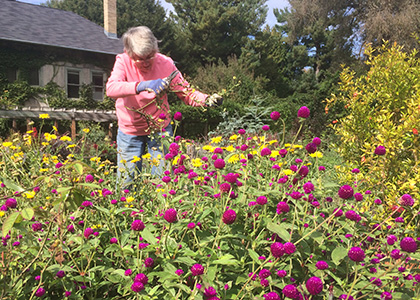
Autumn is quickly approaching and with it comes garden cleanup and spring preparation. At Cornell Botanic Gardens, we maintain healthy collections through effective fall cleanup, winter protection, and spring planning. In that spirit, we’re providing some tips and tricks to keep your garden spectacular year-round.
Use this time to manage and plan for common pests including mammals, weeds, insects and fungi. Consider the beneficial organisms overwintering in your gardens, such as pollinators, and protect their habitat or provide overwintering sites. When ordering plants for the spring, review specific environmental needs, pest susceptibility, and invasive potential.
Deer damage is common throughout the year, including winter. Place a fence around plants affected by feeding and buck rub. Deer repellent can also be applied before temperatures drop to prevent feeding on unfenced specimens. Small mammals can cause major damage through the winter- girdling woody plants and feeding on seeds or herbaceous material indoors. Issues with voles, mice, etc. can be addressed by fencing with hardware cloth, trapping early in fall before populations have time to build up and continuing to trap throughout the winter as needed, and by removing material they can use for shelter in the winter.
Continue weeding into the fall to reduce weed presence the following spring. We use this time to manage for poison ivy, bindweed, garlic mustard, and other unwanted plants. It is also a good time to cut back invasive woody and vining plants like multiflora rose (Rosa multiflora), Ailanthus (Ailanthus altissima), honeysuckle (Lonicera spp.), and porcelain berry (Ampelopsis glandulosa) and treat the stumps with an herbicide.
Scouting for insect and disease pests should continue into the fall. Observations can be used to inform treatment decisions before winter or for the following spring. Some pests, like the Magnolia scale (Neolecanium cornuparvum), can be chemically treated in the fall or spring while others, like the Miscanthus mealybug (Miscanthiococcus miscanthi), are only treated in the spring and summer of the following year. Beneficial nematodes can be utilized in the fall for some insect pests. In the past we have used beneficial nematodes to manage of black vine weevil (Otiorhynchus sulcatus) and Colorado potato beetle (Leptinotarsa decemlineata) in the gardens.
Some tree diseases overwinter on fallen leaves. Every year we see anthracnose on oaks (Apiognomonia quercina), dogwood (Discula sp), and sycamore (Apiognomonia veneta), and septoria leaf spot (Septoria cornicola) on dogwood (Cornus spp.). For these species pathogen presence can be reduced by raking and destroying diseased leaves in autumn. Our gardeners also cut back perennials prone to overwintering diseases, including Botrytis (Botrytis paeoniae) on peony (Paeonia), daylily rust (Puccinia hemerocallidis), and hollyhock rust (Puccinia malvaceraum).
Autumn is also a time when we move plants indoors. Check for pests before bringing plants inside. Some pests may be easily removed by hand or washed off with a hard stream of water, while others will require a biological control and/or chemical spray. Common greenhouse pests include spider mites, aphids, brown soft scale, and mealybugs.
While you are on the lookout for all of these plants and animals that can cause damage, don’t forget about the beneficial organisms that help us out. Pollinators play an important role in the ecosystem. We provide nest sites for native pollinators in the Bioswale Garden and Pounder Garden. These nest sites, including nesting blocks, logs, and tubes, can suffer from winter damage, parasites, and diseases. Woodpecker damage is a concern for nesting blocks in the winter and can be prevented by moving the blocks into an unheated building, or covering the entrances with hardware cloth. The blocks should be moved back outdoors, and hardware cloth should be removed, the following spring before the new bees emerge.
The Xerces Society has some good resources with instructions on maintaining and/or replacing nest sites to prevent the accumulation of bee parasites and diseases. They also offer plant lists that provide food resources throughout the growing season.
When planning for the following spring, consider including pollinator plants in the garden. Our herb gardener often observes pollinator preference toward the following:
Pycnanthemum muticum -clustered mountain mint
Pycnanthemum pilosum – hairy mountain mint
Pycnanthemum tenuifolium– narrow leaf mountain mint
Monarda didyma– bee balm/Oswego tea
Monarda fistulosa -wild bergamot
Angelica atropurpurea -purplestem angelica
Symphyotricum novae-angliae– New England aster
Solidago sp. – goldenrod
Echinacea purpurea
Helianthus annuus– sunflower
Hydrangea arborescens – smooth hydrangea
Allium cernuum -nodding onion
Parthenium integrifolium – American feverfew
Veronicastrum virginicum – Culver’s root
Asclepius syriaca– common milkweed
Asclepius incarnata – swamp milkweed
Asclepius tuberosa – butterfly weed
Lastly, take time to consider what plants to incorporate in the garden next year and their environmental requirements such as space, soil, and watering needs. Review pests known to be an issue on these plants and consider resistant alternatives if available. If the plant is known to have invasive qualities look into alternative species that are native or non-invasive and offer the same characteristics you are looking for such as color, form, and bloom time.
Written by staff integrated pest management specialists, Zaidee Powers-Rosales